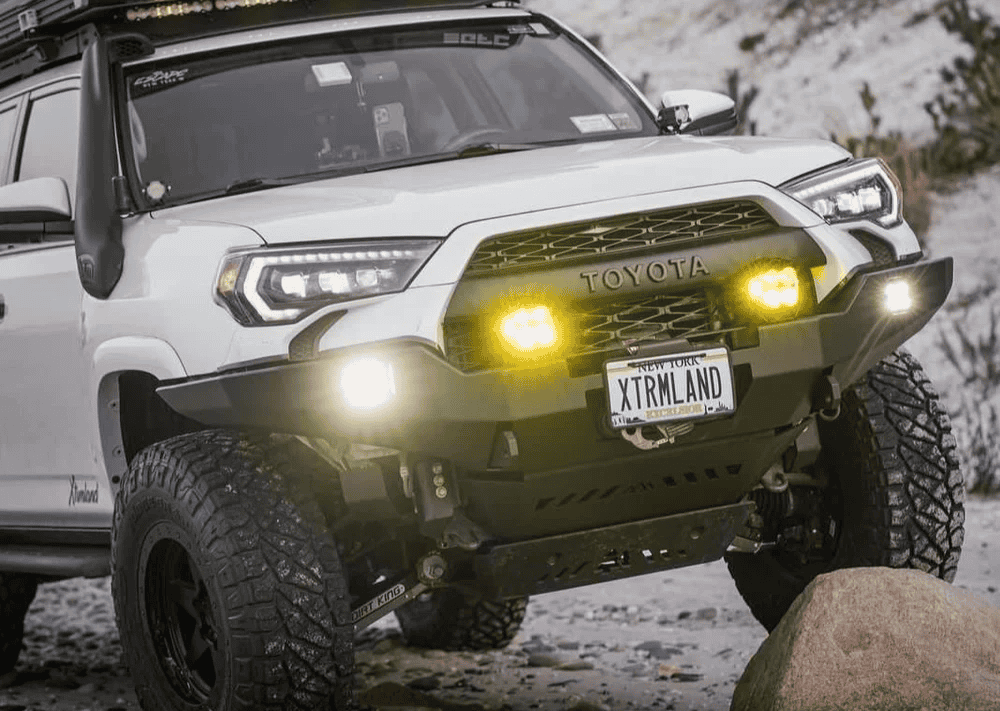Overland Vehicles

Large truck tires carry serious load and run at higher pressures, so a roadside kit needs to be tougher than what you would stash in a compact car. Look for T handle tools that do not flex, a carbide or spiral reamer sized for truck punctures, and plugs that can seal through steel belts. A patch plug stem is the gold standard for lasting repairs when installed from the inside, while rope style plugs can serve as a temporary fix to get you moving. Add vulcanizing cement, extra plugs, alcohol wipes, and a razor to trim any excess. Round it out with spare valve cores and caps, a core tool, nitrile gloves, and shop towels.
Truck tires often have steel belts that fight back against weak tools. A sturdy T handle reamer helps open and clean the channel without wobble. The insertion tool should have a solid shaft and a slotted tip that grips the plug under load. Cheap tools can twist or snap, which turns a simple puncture into a bigger problem.
Liquid sealants can help with very small leaks but are not a fix for punctures through the tread or damage near the shoulder. Rope plugs are fast and useful for emergency situations. For a lasting repair, a patch plug installed from inside the casing seals the injury and fills the path through the tread, which reduces moisture intrusion and belt separation risk.
Start with scene safety. Park well off traffic if possible, set wheel chocks, and engage hazard lights. Use cones or reflectors to create a buffer. If the truck sits on a slope or soft shoulder, reconsider whether a mobile repair is worth the risk. Never crawl under an unsupported vehicle and never work in a live lane.
Locate the leak with soapy water or a spray bottle and mark the injury. Remove the object if visible. Use the reamer to clean and size the hole, then load the plug in the insertion tool with cement. Insert until the plug passes the belts and seats, then withdraw with a steady pull so a short tail remains. Trim flush with the tread once the cement sets.
Reinflate with a compressor that can reach the required pressure for your axle load. Use a gauge that reads accurately at truck pressures and check again after a few minutes. If the tire loses pressure or bubbles remain at the repair site during a soapy water test, the tire should be removed and inspected from the inside by a qualified technician.
Not every injury can be saved. Damage in the sidewall or shoulder, tears larger than the plug size, cuts, or punctures at an angle that compromises the belts all call for replacement. If the casing ran flat under load, internal damage may be hidden even if the tire looks normal. A plug should get you to a service bay, not serve as a permanent fix unless the tire is dismounted and a proper patch plug is installed.
Preparation matters more than speed. Keep a compressor capable of sustained duty, a high flow hose with a clip on chuck, and an inflator with a built in gauge. A bottle jack or a service jack with stands, a torque wrench, and a breaker bar with the correct socket help if you must swap to a spare. Add a reflective vest, headlamp, and kneeling pad so you can work cleanly at night.
Hitting potholes, curbs, or construction debris can push the need for a kit from nice to essential. Regular pressure checks, load rated tires suited to your gross weight, and a walk around before long drives prevent many road shoulder dramas. Keep your kit clean, restock used items, and inspect tools so they are ready when you are.
Modern trucks often include tire pressure monitoring that will alert you early. Use that warning as a prompt to find a safe place to inspect rather than drive until the tire fails. After any repair or tire change, recheck torque after some miles of driving, and keep an eye on temperature and pressure while the tire returns to normal service.
If you run gravel, haul gear, or travel remote routes, consider adding onboard air, work lighting, and dedicated storage for tire tools. A well organized kit turns a stressful stop into a controlled pit style routine.
For drivers who want a purpose built setup that keeps repair gear close, lighting positioned where you need it, and air ready at the press of a switch, OZK Customs builds trucks and vans with the right support systems for long miles and rough terrain. Explore our Overland rigs to see how integrated storage, compressors, and recovery gear fit into a clean layout. If you need a tailored system built around your use case, our Custom overland upfit options cover electrical, lighting, racks, and tire service tools. Want to learn how we approach reliability and serviceability on every build? Visit Why choose OZK Customs.
Make your next stop the smooth one. Tell us how you travel, what you haul, and where you drive so we can design a smart layout with onboard air, secure tool storage, and lighting that makes roadside work safer and faster. Our team builds rigs that are ready for real miles and real work.
Ready for a rig that carries the right recovery tools, onboard air, lighting, and secure storage for roadwork and trail duty? Tell us how you travel and we will build the system around your needs. Submit the form and let OZK plan a durable, serviceable setup that keeps your truck moving.
ADDRESS:
6159 E Huntsville Rd, Fayetteville, AR 72701
PHONE:
(479) 326-9200
EMAIL:
info@ozkvans.com